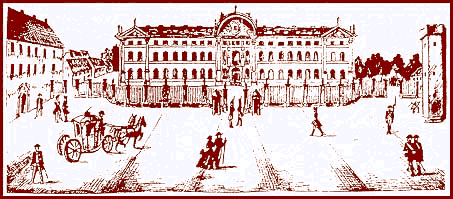|
Zweibrucken - A Short History

The real history of
Zweibrucken as taken from a pamphlet prepared by the Special Services
Libraries, U S Army Area Command which was distributed around 1966. (For all other addressees, this is a
courtesy copy of a very interesting place).
A horse, a rose, and
two bridges -- the symbols and essence of Zweibrucken. The very name Zweibrucken is derived
from the fact that there are two (zwei) bridges (brucken) in the town. The horse represents one of the oldest
and most venerable occupations of the city -- horse-breeding.
Horses bred and raised in Zweibrucken since 1744 are known throughout Europe and
the world. Many winners of races
throughout Europe can be traced to stud farms here. The beauty of roses grown here is legend
and are to be seen in the "Rosengarten," a special park which offers
roses and a variety of other flowers every spring and summer.
Zweibrucken is located
in the western sector of Germany not far from the Saar, which because of its
great concentration of industry, was extremely important during World War II. Crumbling and damaged bunkers which
surround the city form part of the famous Siegfried Line.
In April 1957,
Zweibrucken celebrated its 600th anniversary as a city. The foundations of the city were laid
when the Merovingians, the Counts of Saarbrucken, established a custom-house at
Zweibrucken to control the resources of this area and nearby Hornbach in the mid
1350's.The independent line of the Dukes of Zweibrucken arose
following the sale of the city to the Count Electors Palatine.
During the Thirty Years War, Zweibrucken was held and defended by the Swedish
fighting under King
Gustav Adolph. Three Swedish kings
were descended from the Zweibrucken Dukai line, Charles X, Charles XI, and Charles XII.Under Karl XII the Duchy became a Swedish
province. Friendly ties with Sweden continued for
many years after the end of Swedish government and recently were renewed when
the Swedish legation in Germany informed the city authorities (in 1966) of the
country's intention to include Zweibrucken in the list of places to be visited
by the Swedish International Tourist Organization.
Zweibrucken was the
cradle of the last royal family of Bavaria, the house of Wittelsbach, whose
ancestral castle is still standing. The
architecture of the heart of the city reflected the Swedish Renaissance under
the influence of the architect Sundahl, and mingled with the baroque to give
Zweibrucken a
distinctive character.
Like Ludwig, the Duke was a solitary
person and resented any attempt to approach the castle, so spacious rooms and
inviting hallways remained empty.
style="mso-spacerun: yes"> The beautiful building was so completely
destroyed by the French in 1794 that scarcely a trace remains today. The regiment lost
twenty-nine men in this attack but the assault resulted in the surrender of
8,000 British troops under the command of Lord Cornwallis.
Wilhelm von Zweibrucken wounded in
battle, was made a Colonel and decorated with the High Order of St. Louis while
his brother, Christian (the regimental commander), was awarded the rank of
General. Three diaries kept by officers of the
regiment are still in existence giving proof to the events during the campaign
of 1780 - 1782. Of all the wars, the
most destructive to the city was World War II.
style="font-size:10.0pt;font-family:"Courier New""> For centuries
Zweibrucken, as well as its vicinity, has been the residence of many royalties.
A short distance outside the city stands
the Fasanerie Gasthaus, surrounded by large old trees. Refreshing to visit in summer, history
states that the building once was used by Stanislaus Leszcynski, one of Poland's
kings during the 18th century after he had dethroned King August, the Strong.Horse racing attracts many to the area
and another type of racing -- gass tract -- or motorcycle racing is also
important. The award for the winner of this race is fittingly, a silver rose.
Located near the Rosengarten, the
Festhalle attracts a number of patrons of plays, operas, dramas, and concerts
during the year. The modern city of Zweibrucken of concrete,
steel and glass is a worthy successor to the honored ancient home of kings. During the many wars of the area, farm
houses were built up around the monastery to shield and to hide it. Only a few years ago the grave of St. Primin, who founded
this his tenth and last monastery in 743, was discovered and a chapel erected
over the site. The borders of Saarland, Germany and
France once met at Hornbach forming the "Three Country Corner."
Zweibrucken is within
easy traveling distance from many of the great cities of Europe -- only 227 miles
from Paris, 55 miles from Metz, 85 miles from Frankfurt, 47 miles from
Strasbourg, and 205 miles from Munich.
Respectfully
submitted by David King, inhabitant 1963 - 1966
|